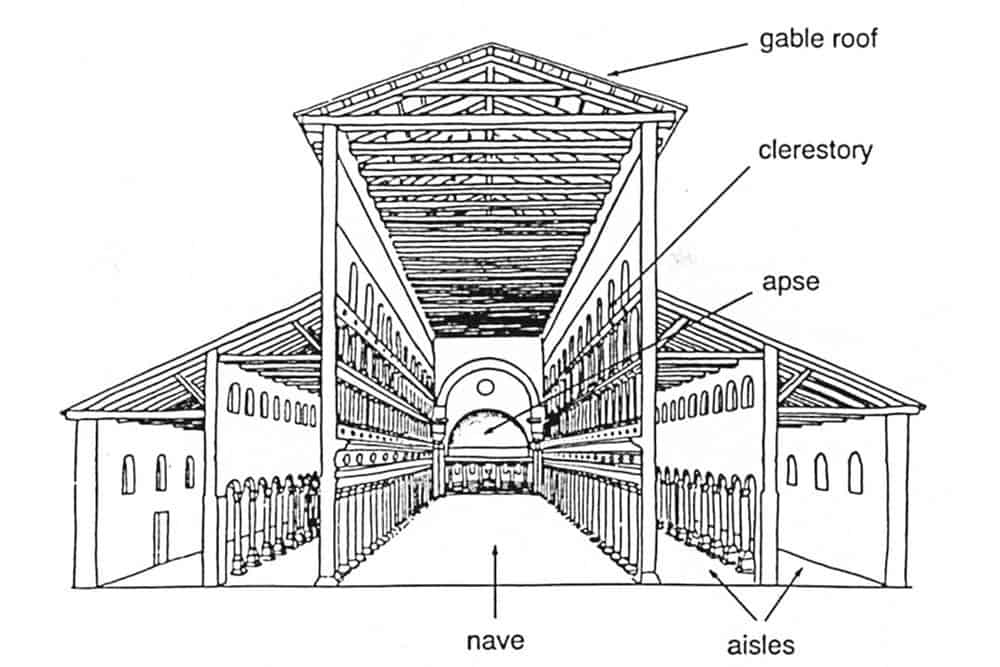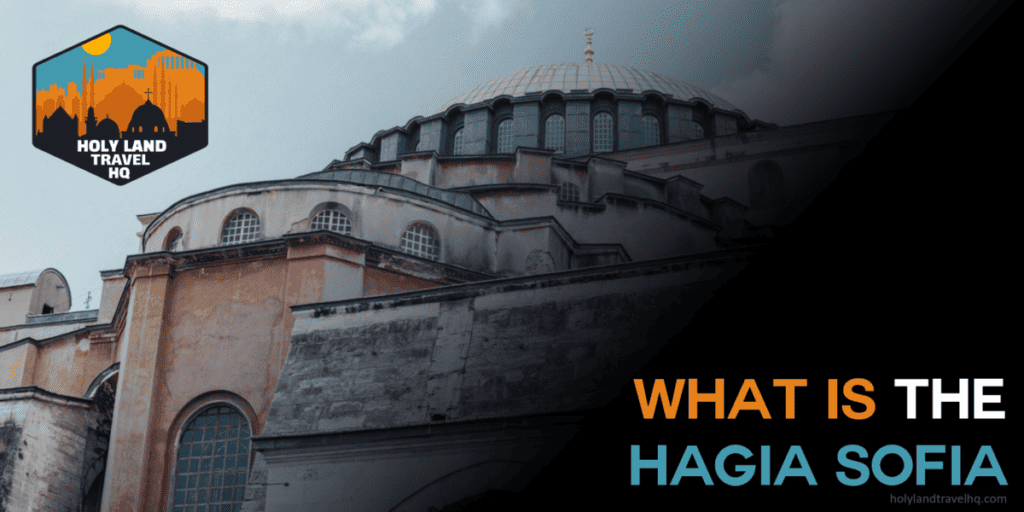
On July 11th, 2020 Turkey reclassified the Hagia Sophia from a museum to a mosque. For most in the Christian academic world, this was a bit of a shock. News of the move was lightly covered though. The politics are difficult to understand and the significance of the cathedral isn’t well known.
So, what is the Hagia Sophia and why is it important? Latin for ‘Holy Wisdom’, Hagia Sophia was the state cathedral for the Eastern Roman Empire. It was commissioned by Emperor Justinian I in the 6th Century CE to be the focal point of Byzantine culture, politics, art and religious practice. Between 1934 and 2020 it was a museum and UNESCO world heritage site. Today it is a mosque.
For over 900 years Hagia Sophia was an Orthodox Christian church. When the Ottomans gained control in 1453 CE, they repurposed the structure into a mosque. In 1934, after a secular nationalist movement established a new government, Hagia Sophia was designated a museum.
Hagia Sophia’s structure, colorful mosaics, and marble panels make it one of the most fascinating historical sites still standing. It was an engineering project ahead of its time with its intricate web of domes.
Let’s take a closer look at Hagia Sophia.
All links are direct.
Where is Hagia Sophia located?
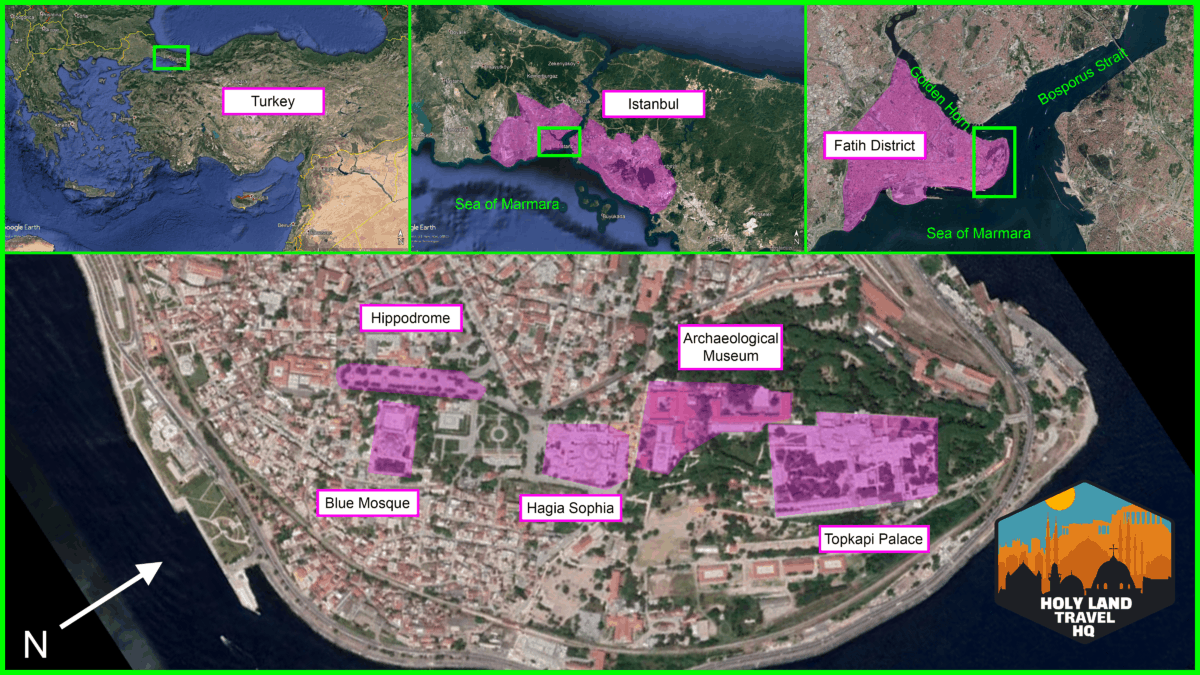
Hagia Sophia is located on the eastern point of the Fatih district of Istanbul, Turkey. The Fatih district is the portion of the city where historic Constantinople once stood. The eastern point overlooks the Bosporus Strait, the Sea of Marmara and the estuary known as the Golden Horn.
Roughly 500 yards to the north of Hagia Sophia sits the Topkapi Palace and the Istanbul Archaeological Museum.
About 300 yards to the south of Hagia Sophia sits the Sultan Ahmet Mosque, also known as the Blue Mosque. In front of the Blue Mosque is an elongated public square that marks the location of the historic Byzantine Hippodrome. This was a sports arena used primarily for chariot racing.
Why was Hagia Sophia built?
The Hagia Sophia was built to fulfill Emperor Justinian’s vision for a harmonized society. He wanted the structure to be the center of culture and life. But he didn’t come up with idea on the fly. There was a lead up to it.
When Constantine established sole emperorship of the Roman Empire in 324 CE he wanted a change. Rome was a dying city.
On the Bosphorus, the city of Byzantium was fresh and wealthy. As the gateway to Asia and the grain-rich areas of the Black Sea it had great power. In 330 CE Constantine renamed the city Constantinople and moved.
Unfortunately, like David, Constantine was unable to build a temple before his death. Though his son, Constantius, was not as religious, a pagan temple was razed and the Magna Ecclesia was built. Translated as the Great Church, the structure was consecrated in 360 CE.
In 404 CE, a riot broke out after the Archbishop of Constantinople, John Chrysostom, was exiled over a disagreement with the Empress. The Magna Ecclesia was burned to the ground.
In 415 CE, Emperor Theodosios II consecrated a new, larger church.
In 532 CE, a 5-day riot, known as the Nika Riots, broke out during a chariot race in the Hippodrome. The issue was less about the race and more about frustration with a corrupt government though. The rioting moved to the palace and eventually the church.
With the encouragement of his wife, Theodora, Justinian set out to rebuild. Part of his new vision was to shift the focus from the Hippodrome back to Christian religious life. What came out of this was a vision for a new church that was much bigger. And more central to Byzantine life than before.
What did the Magna Ecclesia look like?
Not much is left of either iteration of the Magna Ecclesia. It’s thought that some of the rubble may have been used as fill for Hagia Sophia’s foundation pad. However, there have been pieces that were found around Hagia Sophia.
These pieces point to an architectural style that Constantine used in other basilicas at the time. Including the Martyrion of the original Church of the Holy Sepulchre in Jerusalem, finished in 335 CE.
These structures were rectangle in shape with the central nave covered by a raised clerestory. The gabled roof was supported by wooden trusses. Columns supported the clerestory and roof. And aisles extended the space laterally with the help of more columns and arches.
Though these structures could be spruced up with frescoes, mosaics and accoutrement; they didn’t inspire awe. Which is possibly why the 404 CE and 532 CE riots saw the Magna Ecclesia as fodder for their anger.
Who built Hagia Sophia?
Emperor Justinian contracted Anthemius of Tralles and Isidore of Miletus to design and build Hagia Sophia. Both men are described in numerous resources as mathematicians, architects, engineers, geometers, and universal men.
Regardless of how their knowledge is described, they were intelligent and well versed in geometric design. Which explains how the elaborate web of domes and arches came about.
To complete the project the duo employed more than 10,000 workers over a 6 year construction period.
What does Hagia Sophia mean?
Hagia Sophia means ‘Holy Wisdom’ and it comes from the Koine Greek language. The Greek pronunciation is Ah-gia So-fia with the ‘H’ having been added in Roman circles.
In Latin ‘Holy Wisdom’ is translated as Sancta Sophia.
The official title of the Hagia Sophia as of July 2020 is the Hagia Sophia Grand Mosque. Or, Ayasofya-I Kebir Cami-I Serifi in Turkish. Ayasofya for short.
The name Hagia Sophia was first used in the 5th century as a nickname for the second iteration of the Magna Ecclesia. When that structure was destroyed in 532 CE, the original name was dropped. The structure we see today was built under the official name, the Holy Wisdom.
Is Hagia Sophia the same as the Blue Mosque?

Hagia Sophia is not the Blue Mosque. They are two distinct features in the Istanbul skyline. And they sit next to each other, separated by about 3 football field lengths.
The Blue Mosque, officially titled the Sultan Ahmet Mosque, began construction in 1609 and was completed in 1616. It was named after Ahmet I, Sultan of the Ottoman Empire between 1603 and 1617.
Ahmet ascended to the throne at the age of 13 when his father, Mehmed III, died. He is known for two contributions to the Ottoman Empire.
The first was an end to the practice of killing one’s brothers when you take the throne. This wasn’t due to any devotion to compassion though. Ahmet was too young to father children when he took the throne. His brother was held as the backup to carry the seed forward if Ahmet was murdered or died young.
The Second is the Blue Mosque. Ahmet commissioned the project in order to reiterate Ottoman power.
The Blue Mosque is not as large as Hagia Sophia, but it’s still impressive. As it’s architectural style attempts to mimic Hagia Sophia.
The most notable difference between the two is their domes. Hagia Sophia sports an open space underneath a dome that is 180 ft above ground. It is supported by a web of domes and pendentives. The Blue Mosque’s dome is only 141 ft high and supported by 4 large pillars.
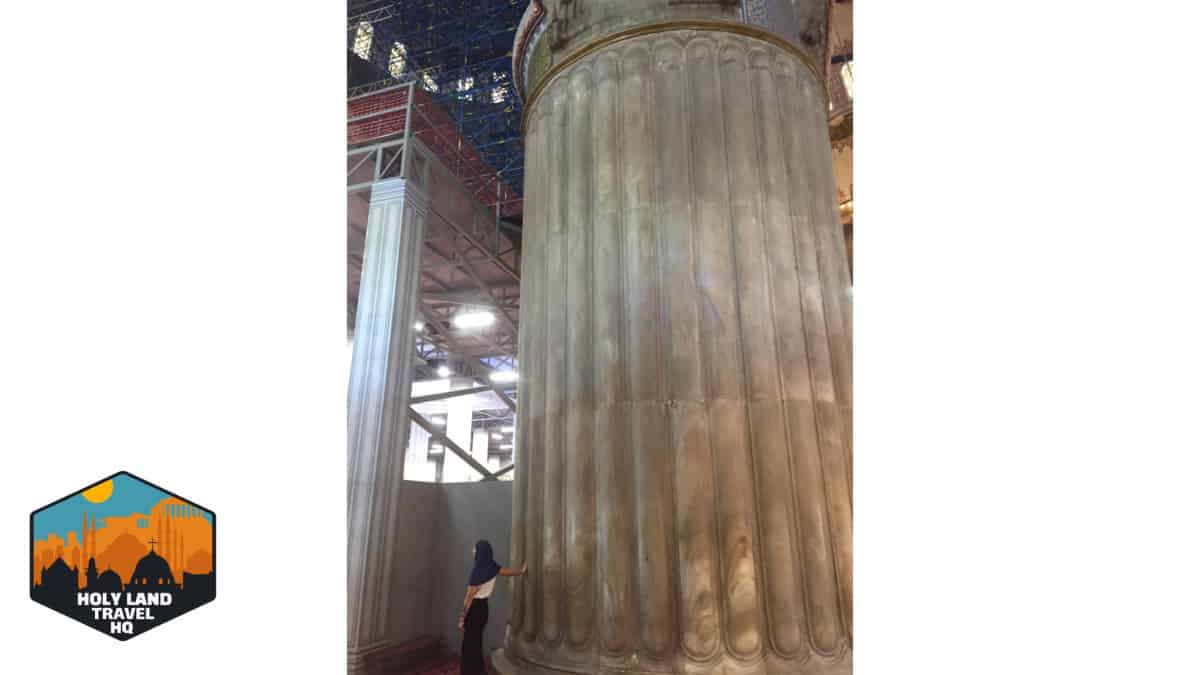
It’s easy to ding the builders of the Blue Mosque for “cutting corners.” They used pillars instead of going full ‘Hagia Sophia’ with pendentive arches and domes. But that’s not the full story.

Ottoman builders used 20,000 ceramic tiles to decorate the interior of the Blue Mosque. And it’s impressive! The blue hue of the Isnik style mosaics gave the mosque its nickname.
The Architecture of Hagia Sophia.
Hagia Sophia is the epitome of Byzantine design. Structurally and stylistically, Byzantine architecture is no different than Roman architecture. What sets the two apart is the elaborate use of domes, artistic mosaics, and frescoes by Byzantine builders.
Whereas the Church of the Holy Sepulchre is a mix of Roman and Byzantine, Hagia Sophia is strictly Byzantine.
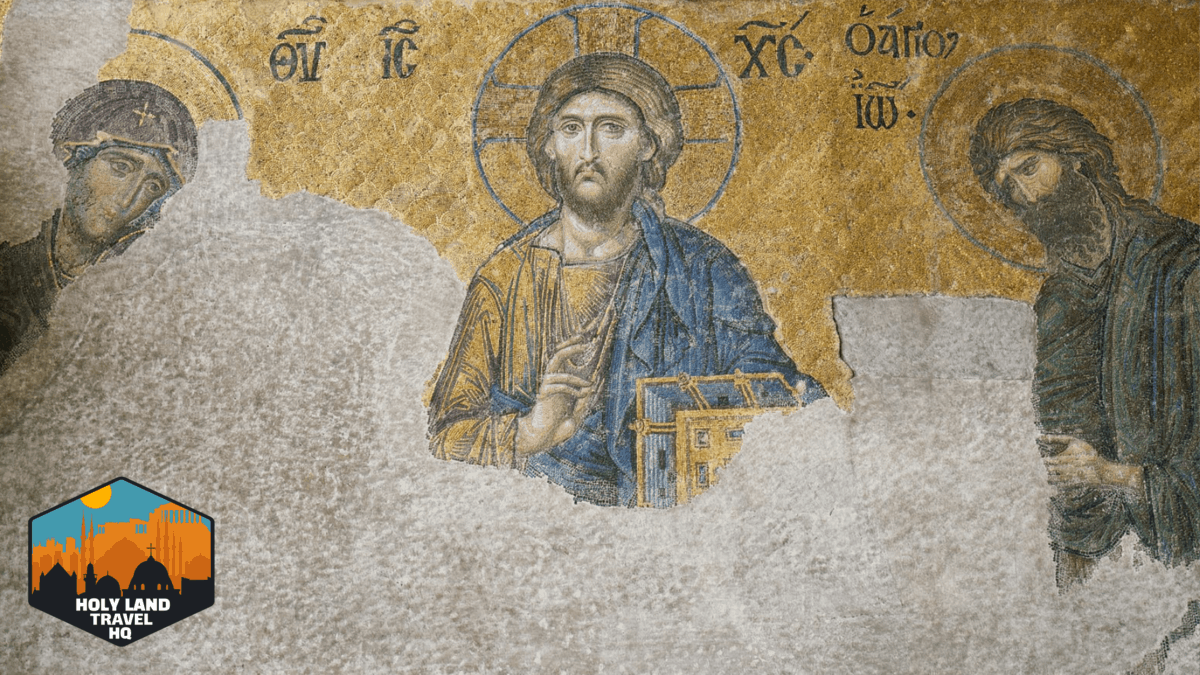
The interior was covered with artistic mosaics and frescoes depicting Jesus, Mary, angels, and other heavenly imagery. I say “was” because the Muslim Ottomans removed or covered them up. What’s left is sparse and severely damaged. The most notable is the Deisis mosaic which depicts Jesus with Mary and John the Baptist on either side.
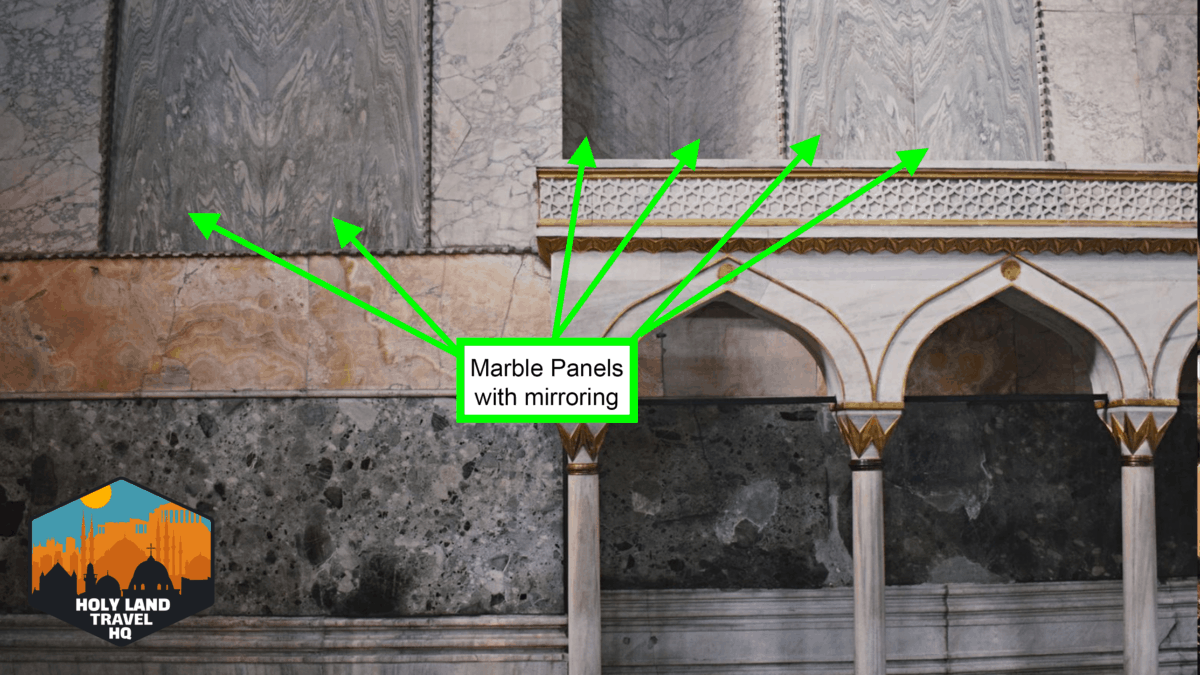
Marble panels were precisely cut for placement among the art. But these panels weren’t just cut and placed. Marble panels were sliced from the block like bread using twisted strands of silkworm silk. They were then placed in pairs with the grain mirroring each other.
Approximately 40,000 pounds of silver is said to adorn the interior of Hagia Sophia. But quite possibly the most impressive part of its architecture is its domed roof and the floorspace it covers.

The top of the main dome is 180 feet high. Its diameter is 108 feet wide and it rests on 2 half-domes which then rest on 4 pendentives. A pendentive is a triangular segment of a sphere. So, they aren’t full domes but their arched shape holds the weight of the domes above them.
This elaborate structure is what creates the vast open floor design of the main interior. It was the largest open floor plan known to the world until the 15th century.
How has Hagia Sophia been altered?
Istanbul sits on a fault line. As a result, Hagia Sophia has been susceptible to earthquakes and shifting for over 1,500 years.
Within 25 years of its completion earthquakes started to cause cracks in the main dome. The original dome was too flat and this made it structurally weak. In 558 CE the main dome fell. Justinian contracted the nephew of Isidore of Miletus, Isidorus the Younger to make the repairs.
Isidorus designed a new dome, the one we see today.

Throughout its 1,500-year history, earthquakes have plagued Hagia Sophia. Numerous buttresses have been added to the exterior of the structure. These devices added mass and reinforced the walls holding up the domes.
In 1203 CE, during the 4th Crusade, gold and silver accoutrements were taken to pay off crusaders. They had helped Isaac II Angelus return to the throne. In 1204 CE the crusaders sacked Constantinople and ransacked Hagia Sophia.
Numerous other alterations, renovations, and additions have been made through Hagia Sophia’s history. Most of which have been driven by maintenance and repair needs.
How did Hagia Sophia become a mosque?
When the Ottomans conquered Constantinople in 1453 CE, Sultan Mehmed’s first act was to conduct Friday prayer in Hagia Sophia. This consecrated the building as a mosque. The alter was consequently turned into a mihrab, which is a niche that points to the direction of prayer. Also known as the qibla.
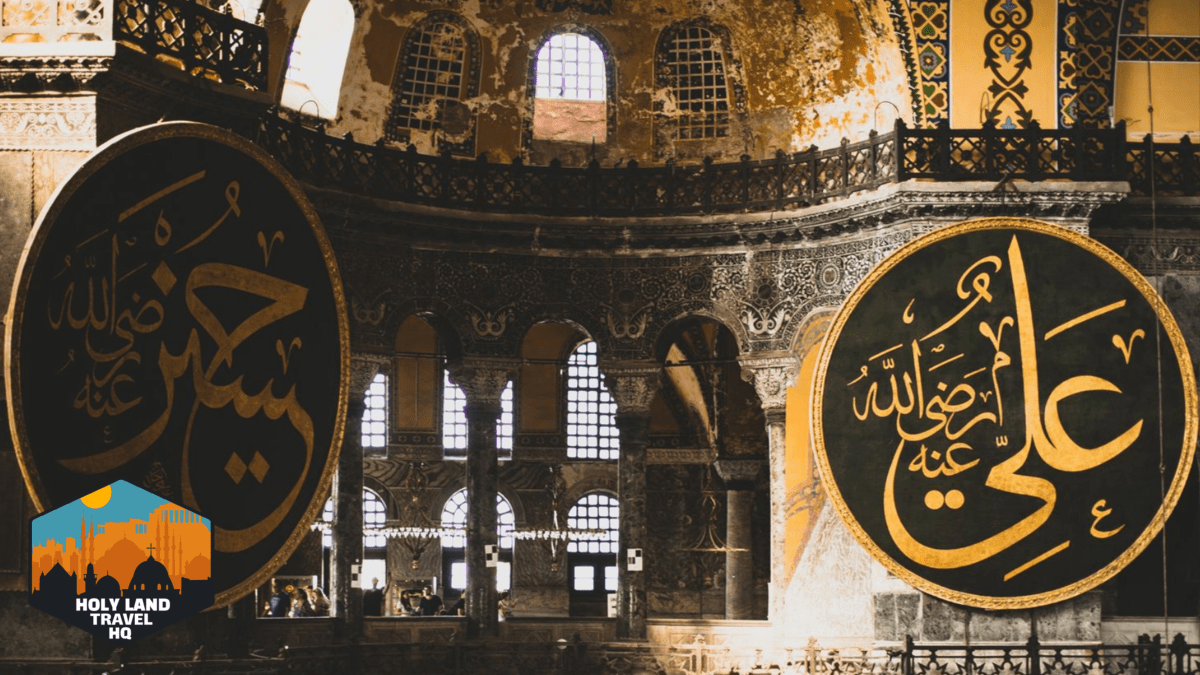
Due to Islamic law forbidding human images being displayed, plaster was used to cover up the mosaics and frescoes. Large wooden medallions were hung around the sanctuary emblazoned with names of Allah, Mohammad and the 4 caliphs.
In 1481 CE a wooden minaret was installed in order to perform the call to prayer. In the 16th century, the wooden minaret and another minaret were replaced by two large minarets. These were altered in the 19th century when 2 additional minarets were added, giving Hagia Sophia the look we see today.
Who turned Hagia Sophia into a museum?
In WWI the Ottoman Empire joined with the Central Powers; Austria-Hungary, Bulgaria, and Germany. As we know, the Central Powers lost.
During the occupation of Istanbul by the Allies, the Turkish National Movement began. The Turkish War of Independence ensued. Mustafa Kemal, a former Ottoman Field Marshall lead the movement in expelling the occupying forces.
In 1923 the Treaty of Lausanne was signed and the Republic of Turkey was recognized. Mustafa Kemal became the first president and was bestowed with the honorable surname of Ataturk. Which means “father Turk.”
Mustafa Kemal was a secularist and introduced several reforms to bring the new Republic of Turkey into the modern age. His government was marked by the idea that religion and politics should be separate. As a result of this, he transformed Hagia Sophia into a museum.
Under its new designation, Hagia Sophia welcomed a wave of scholars, art historians, and conservationists. Much of the plaster that was used to cover up the Byzantine mosaics was removed. The large wooden Islamic medallions remained though.
As a museum, Hagia Sophia was open to everyone. In 2019 alone, Turkey welcomed 50 million visitors. Though most came from Eastern Europe and Russia, Christians in particular visit to see sites related to Christian history. Sites like Ephesus, Laodicea, and Hagia Sophia.
Who turned Hagia Sophia into a mosque again?
On July 11th, 2020, Hagia Sophia was rebranded back to a mosque by the President of Turkey, Recep Tayyip Erdoğan. The event went largely uncovered by western media outlets. However, it was staunchly opposed by the Vatican and the Greek Government.
Although it came as a surprise to many, it really isn’t much of a surprise. Erdoğan spent most of his first term trying to reform the government.
The Turkish government is a parliamentary one. Its head of state is the President, but its head of government is the Prime minister and elected by parliament. Before being elected President of Turkey in 2014, Erdoğan was the Prime Minister from 2003 until 2014.
Erdoğan is resolutely pro-presidential government.
In 2013, anti-government protests resulting in the government imposing strict censorship on social media and internet sites. In 2016 a failed coup attempt resulted in the ousting of government officials seen as sympathetic to the resistance.
Unlike the US Government’s system of decentralization and checks-and-balances, the Turkish government is much more centralized. Left unchecked, a presidential system can provide centralized leaders with an unbalanced amount of power.
Needless to say, it’s no wonder Erdoğan has been accused of being a dictator.
Another aspect at play here is how societies beat their chests. In the west, it’s national exceptionalism. In the world of Islam, it’s Islamic exceptionalism versus everyone else.
The decision to revert Hagia Sophia back to a mosque was a religious one to a certain extent. Erdoğan likes the theocratic powers his contemporaries around him have. But this decision was more political than anything. Erdoğan needed a distraction and a win.
In 1616 Sultan Ahmet reasserted Ottoman power by building the Blue Mosque. In 2020 Erdoğan asserted Turkish power by reclaiming Hagia Sofia for Islam.
Why is Hagia Sophia so important?
Hagia Sophia is important because of its impact on Byzantine architecture and its 1,500 year and counting history.
Byzantine style and culture wouldn’t be what it was without Hagia Sophia. Nor would the modern world. The unique use of color, art, and engineering to design a structure for more than function was monumental. Justinian’s vision of creating a focal point for religious practice as well as society, culture, art, and politics carried forward.
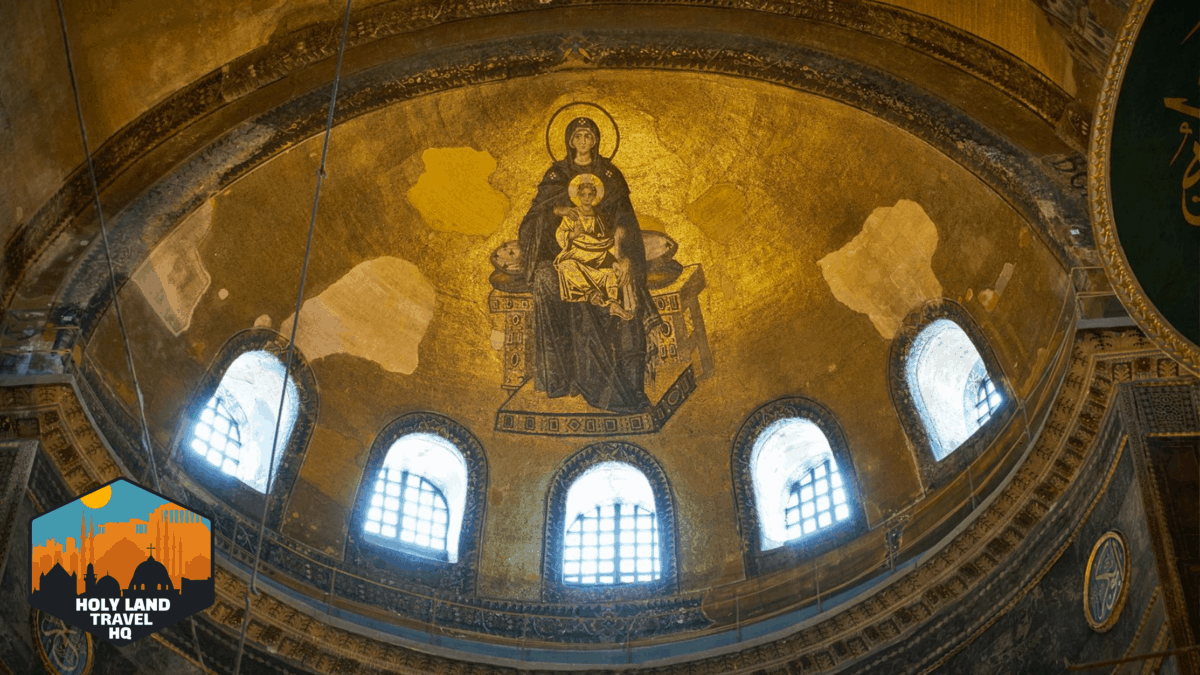
Throughout history we’ve seen others repeat this vision. We see it in the Sistine Chapel. Notre Dame. Even the rotunda of the U.S. capitol building. Even the Blue Mosque takes its style from Hagia Sophia.
Most modern city skylines are populated with architectural feats designed to appeal as much as they function. Hagia Sophia was the forebear of this idea .
It is rare for structures to stand the test of time, but Hagia Sophia remains standing after a millennium and a half. It would be understandable for it to crumble from an earthquake. But it would be a travesty to watch it fall to the fallibility of humanity.
Can you still visit Hagia Sophia?
Yes, you can still visit Hagia Sophia. Turkey has stated that Hagia Sophia will remain open to everyone, not just Muslims. Christians can take comfort in this fact because the Blue Mosque is also open to tourists.
A dress code will most likely be put into effect. Women will be required to cover their shoulders and legs. At the Blue Mosque, waist wraps are available for women who do not have the proper attire.
Tourism is huge in Turkey. The western and southwestern coasts are littered with significant ancient ruins. Ephesus is the largest uncovered site of the ancient world. And it’s well maintained.
The academic class that produces scholars, archaeologists, historians, and conservationists is significant in Turkey. Because of this, I don’t see Turkey removing any of the distinctly Christian iconography in Hagia Sophia. However, I do see them covering these things with non-destructive material such as wood panels.
Just like the Blue Mosque and the Temple Mount in Jerusalem, I see Turkey holding tourist hours. As an active mosque, Hagia Sophia will be required to support Islamic rituals like Ramadan and the call to prayer.
How to visit Hagia Sophia.
Under its designation as a museum Hagia Sophia was open Tuesday through Sunday. Winter hours (October to April) are 9am – 5pm. Summer hours (April to October) are 9am – 7pm. Ticket prices are around $15 USD. The ticket office closes 1 hour before site closing.
Hagia Sophia is also closed for the first few days of Ramadan. And half the day on Eid Ul Adha, or the Feast of Sacrifice.
If you are not with a tour group, guided tours are also offered for around $9 USD.
Will Hagia Sophia be a church again?
There are two potential roads here. Both involve Erdoğan losing his seat as President.
The first road is that tourism and the economy suffer from Erdoğan’s policies. He loses an election or is removed by his own party. A new administration comes in and restarts the economy by focusing on tourism. And Hagia Sophia is reclassified a museum.
The other road I see has the same start. Erdoğan’s policies will lead to a suffering economy and he will lose an election. But the new administration will overlook Hagia Sophia, viewing it as a normalized situation and thus, move on.
I don’t see Hagia Sophia becoming a church again. At least not in my lifetime. The best we can hope for is that it gets turned back into a museum.
Resources Used.
American Society of Civil Engineers


